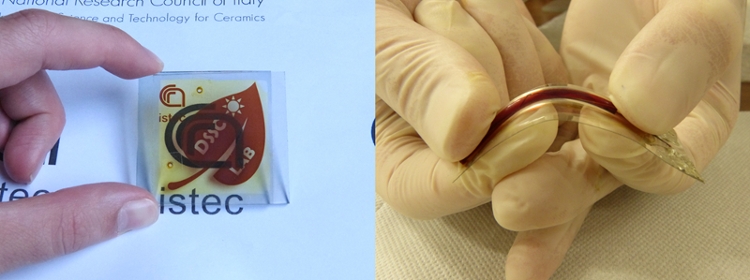This website uses cookies so that we can provide you with the best user experience possible. Cookie information is stored in your browser and performs functions such as recognising you when you return to our website and helping our team to understand which sections of the website you find most interesting and useful. More information in our Privacy Policy
Third generation photovoltaic
Dye-Sensitized Solar Cells (DSSCs) and Perovskites
Principal investigators: Alessandra Sanson, Alex Sangiorgi
Involved personnel: Nicola Sangiorgi
Dye-Sensitized solar cells, also known as Grätzel cells, are devices used to directly convert solar light into electricity. In 1991 O’Regan and Grätzel realized the first prototypes of dye solar cells with good efficiency using low-cost materials if compared to silicon solar cells.
DSSCs are constituted by multilayer materials with a selected band gap that allow photon adsorption and electron injection in the conduction band of the anodic material to produce electricity. In more detail, these particular photoelectrochemical cells are principally composed of a photoanode, a counter electrode, and an electrolyte system to close the circuit. The first component is traditionally a conductive transparent glass substrate (FTO glass) covered with a 10 μm thick TiO2 mesoporous layer. The latter is then sensitized with a suitable metalorganic dye that captures the solar radiation. Also, the cathode is normally constituted by an FTO glass covered with a nanometric metallic film that acts as a catalyst (e.g. Pt). Finally, the electrolyte solution is generally constituted by the mixture of an organic solvent containing a redox couple (i.e. I–/I3–).
CNR-ISTEC is mainly involved in the study and optimization of DSC prototypes build on flat rigid and flexible substrates and also in fiber form, with particular attention to materials and technologies for the realization of (i) engineered semiconductor-based films, (ii) quasi-solid electrolytes and (iii) Pt-free counter electrodes. Moreover, the expertise in the development and production of low melting glass ceramics is also exploited to develop suitable sealing systems.
The solar cell prototype is ideated in view of its industrial production; for this reason, the selection of materials, deposition processes, and relative characterizations are directed toward the minimization of the time and production costs.

Main partners
• Consorzio Dyepower
• Istituto di Chimica dei Composti OrganoMetallici (CNR-ICCOM)
• Istituto dei Materiali per l’Elettronica ed il Magnetismo (CNR-IMEM)
• Daunia Solar Cells
Projects
Publications and patents
• N. Sangiorgi*, A. Sangiorgi, A. Dessì, L. Zani, M. Calamante, G. Reginato, A. Mordini, A. Sanson, “Improving the efficiency of thin-film fiber-shaped Dye-Sensitized Solar Cells by using organic sensitizers” Solar Energy Materials and Solar Cells 204, (2020),110209.
• N. Sangiorgi*, A. Sangiorgi, F. Tarterini, A. Sanson, “Molecularly Imprinted Polypyrrole counter electrode for gel-state Dye-Sensitized Solar Cells” Electrochimica Acta 305, (2019) 322-328.
• N. Sangiorgi*, A. Sanson, “Influence of electropolymerized polypyrrole optical properties on bifacial Dye-Sensitized Solar Cells”, Polymers 125, (2017) 208-216.
• R. Bendoni*, A.L. Barthélèmy, N. Sangiorgi, A. Sangiorgi, A. Sanson, “Dye-sensitized solar cells based on N719 and cobalt gel electrolyte obtained through a room temperature process” Journal of Photochemistry and Photobiology A: Chemistry 330, (2016) 8–14.
• R. Bendoni*, N. Sangiorgi, A. Sangiorgi, A. Sanson, “Role of water in TiO2 screen-printing inks for Dye-sensitized Solar Cells” Solar Energy 122, (2015) 497-507.
• A. Sangiorgi*, R. Bendoni, N. Sangiorgi, A. Sanson, B. Ballarin, “Optimized TiO2 blocking layer for dye-sensitized solar cells” Ceramics International 40, (2014) 10727-10735.
• Patent, RIF.: 10395 “MATERIALE COMPOSITO COSTITUITO DA SUPPORTI ORGANICI E IDROSSIAPATITE SOSTITUITA CON TITANIO E/O FERRO PER USO IN CELLE SOLARI A COLORANTE ORGANICO”,(2016) Inventori: A. Tampieri, M. Sandri, S. Sprio, A. Sanson, Titolare: Consiglio Nazionale delle Ricerche.
